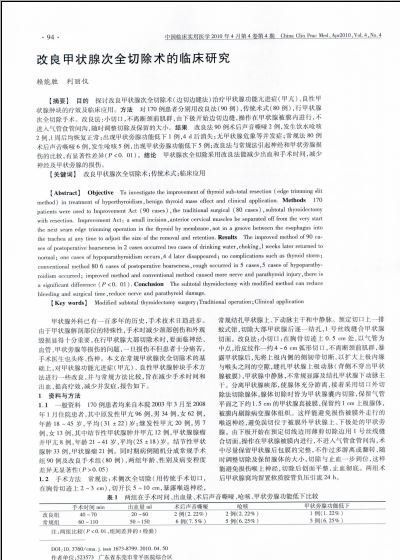改良甲状腺次全切除术的临床研究(1)
 |
| 第1页 |
参见附件(1402KB,2页)。
【摘要】 目的 探讨改良甲状腺次全切除术(边切边缝法)治疗甲状腺功能亢进症(甲亢)、良性甲状腺肿块的疗效及临床应用。方法 对170例患者分别用改良法(90例),传统术式(80例),行甲状腺次全切除手术。改良法:小切口,不离断颈前肌群,由下极开始边切边缝,操作在甲状腺被膜内进行,不进入气管食管间沟,随时调整切除及保留的大小。结果 改良法90例术后声音嘶哑2例,发生饮水呛咳2例,l周后均恢复正常;出现甲状旁腺功能低下1例,4 d后消失;无甲状腺危象等并发症;常规法80例术后声音嘶哑6例,发生呛咳5例,出现甲状旁腺功能低下5例;改良法与常规法引起神经和甲状旁腺损伤的比较,有显著性差异(P<0. 01)。结论 甲状腺次全切除采用改良法能减少出血和手术时间,减少神经及甲状旁腺的损伤。
【关键词】 改良甲状腺次全切除术;传统术式;临床应用
【Abstract】 Objective To investigate the improvement of thyroid sub-total resection (edge trimming slit method) in treatment of hyperthyroidism,benign thyroid mass effect and clinical application. Methods 170 patients were used to Improvement Act (90 cases),the traditional surgical (80 cases),subtotal thyroidectomy with resection. Improvement Act: a small incision,anterior cervical muscles be separated off from the very start the next seam edge trimming operation in the thyroid by membrane,not in a groove between the esophagus into the trachea at any time to adjust the size of the removal and retention.Results The improved method of 90 cases of postoperative hoarseness in 2 cases occurred two cases of drinking water,choking,l weeks later returned to normal; one cases of hypoparathyroidism occurs,4 d later disappeared; no complications such as thyroid storm; conventional method 80 6 cases of postoperative hoarseness,cough occurred in 5 cases,5 cases of hypoparathyroidism occurred; improved method and conventional method caused more nerve and parathyroid injury,there is a significant difference (P<0. 01).Conclusion The subtotal thyroidectomy with modified method can reduce bleeding and surgical time,reduce nerve and parathyroid damage.
【Key words】 Modified subtotal thyroidectomy surgery;Traditional operation;Clinical application
甲状腺外科已有一百多年的历史,手术技术日趋进步。由于甲状腺解剖部位的特殊性,手术时减少颈部创伤和外观毁损显得十分重要,在行甲状腺大部切除术时,要面临神经、血管、甲状旁腺等损伤的问题,一旦损伤不但患者十分痛苦,手术医生也头疼、伤神。本文在常规甲状腺次全切除术的基础上,对甲状腺功能亢进症(甲亢)、 良性甲状腺肿块手术方法进行一些改良,并与常规方法比较,旨在减少手术时间和出血,提高疗效,减少并发症,报告如下。
1 资料与方法
1.1 一般资料 170例患者均来自本院2003年3月至2008年1月住院患者,其中原发性甲亢96例,男34例,女62例,年龄18~45岁,平均(31±22)岁;继发性甲亢20例,男7例,女13例,其中结节性甲状腺肿并甲亢12例,甲状腺腺瘤并甲亢8例,年龄21~41岁,平均(25±18)岁。结节性甲状腺肿33例,甲状腺瘤21例。同时期病例随机分成常规手术组90例及改良手术组(80例),两组年龄、性别及病变程度差异无显著性(P>0.05)
1.2 手术方法 常规法:术侧次全切除(用传统手术切口,在胸骨切迹上2~3 cm),切开长5~10 cm,暴露喉返神经,常规结扎甲状腺上、下动脉主干和中静脉 ......
您现在查看是摘要介绍页,详见PDF附件(1402KB,2页)。